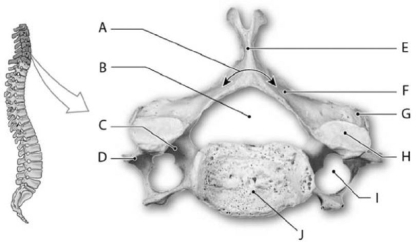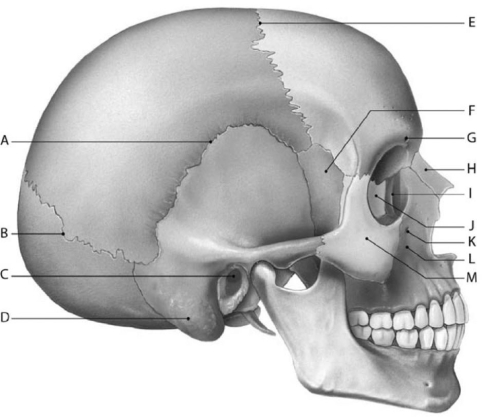A) support
B) protection
C) leverage
D) storage
E) blood cell production
G) B) and E)
Correct Answer

verified
Correct Answer
verified
Multiple Choice
 Photo Credit: Ralph T. Hutchings
Figure 6-3 A Cervical Vertebra (Superior View)
Use Figure 6-3 to identify the labeled part.
-What type of vertebra is this?
Photo Credit: Ralph T. Hutchings
Figure 6-3 A Cervical Vertebra (Superior View)
Use Figure 6-3 to identify the labeled part.
-What type of vertebra is this?
A) cervical
B) thoracic
C) sacral
D) lumbar
E) coccygeal
G) C) and D)
Correct Answer

verified
Correct Answer
verified
Multiple Choice
The primary curves of the vertebral column that develop before birth are the
A) cervical and lumbar.
B) cervical and thoracic.
C) cervical and sacral.
D) thoracic and sacral.
E) thoracic and lumbar.
G) B) and C)
Correct Answer

verified
Correct Answer
verified
Multiple Choice
Osteocytes
A) are giant cells with 50 or more nuclei.
B) are immature bone cells.
C) are the cells responsible for the production of new bone.
D) secrete acids and enzymes.
E) maintain normal bone structure by recycling the calcium salts in the bony matrix around themselves.
G) A) and C)
Correct Answer

verified
Correct Answer
verified
Multiple Choice
The trochlea is a structural feature of which bone?
A) scapula
B) ulna
C) humerus
D) radius
E) clavicle
G) D) and E)
Correct Answer

verified
C
Correct Answer
verified
Multiple Choice
Rickets is a condition marked by a softening and bending of bones that occurs in growing children, as a result of ________ deficiency.
A) vitamin A
B) vitamin D3
C) growth hormone
D) vitamin C
E) thyroid hormone
G) A) and B)
Correct Answer

verified
Correct Answer
verified
Multiple Choice
A structure often associated with synovial joints, but not found in all, is
A) a fibrocartilage pad.
B) a suture.
C) a gomphosis.
D) short dense connective tissue fibers.
E) synovial membrane.
G) B) and D)
Correct Answer

verified
Correct Answer
verified
Multiple Choice
Which of the following curves develops as a child begins to stand and walk?
A) lumbar
B) thoracic
C) sacral
D) coccygeal
E) spinal
G) A) and D)
Correct Answer

verified
Correct Answer
verified
Multiple Choice
 Figure 6-2 Adult Skull (Lateral View)
Use Figure 6-2 to identify the labeled part.
-Structure J is the
Figure 6-2 Adult Skull (Lateral View)
Use Figure 6-2 to identify the labeled part.
-Structure J is the
A) nasal.
B) lacrimal.
C) maxilla.
D) ethmoid.
E) palatine.
G) C) and D)
Correct Answer

verified
Correct Answer
verified
Multiple Choice
The hyoid bone
A) serves as a base for muscles associated with the larynx, tongue, and pharynx.
B) provides a site for the attachment of muscles that rotate or extend the head.
C) marks the point of articulation with the lower jaw.
D) contributes to the nasal septum.
E) is the attachment point for the temporalis muscle.
G) B) and E)
Correct Answer

verified
A
Correct Answer
verified
Multiple Choice
Which two features make up the hinge joint at the elbow?
A) trochlea of humerus and head of the radius
B) head of radius and ulnar notch
C) trochlea of humerus and trochlear notch of ulna
D) coronoid fossa and trochlea of humerus
E) medial condyle and medial epicondyle
G) A) and E)
Correct Answer

verified
Correct Answer
verified
Multiple Choice
Moving the arm in a loop is an example of which angular movement?
A) flexion
B) adduction
C) extension
D) circumduction
E) gliding
G) C) and D)
Correct Answer

verified
Correct Answer
verified
Multiple Choice
 Photo Credit: Ralph T. Hutchings
Figure 6-3 A Cervical Vertebra (Superior View)
Use Figure 6-3 to identify the labeled part.
-This diagram shows a cervical vertebra. What feature would identify it as such?
Photo Credit: Ralph T. Hutchings
Figure 6-3 A Cervical Vertebra (Superior View)
Use Figure 6-3 to identify the labeled part.
-This diagram shows a cervical vertebra. What feature would identify it as such?
A) the presence of the spinous process
B) the presence of the body
C) the presence of articulating facets
D) the presence of the transverse foramen
E) the large size of the vertebra
G) All of the above
Correct Answer

verified
Correct Answer
verified
Multiple Choice
Near the external auditory meatus, the long, sharp process called the ________ process is an attachment site for ligaments that support the hyoid bone.
A) mastoid
B) styloid
C) occipital
D) condyloid
E) temporal
G) A) and D)
Correct Answer

verified
B
Correct Answer
verified
Multiple Choice
Older individuals suffer from a much higher proportion of hip fractures than the young. Why?
A) Children fall less than people in their middle ages and on.
B) Older people have less bone density than the young.
C) The hip is not a stable joint.
D) The elderly have a greater incidence of arthritis.
E) Hip fractures take longer to heal in older individuals.
G) C) and E)
Correct Answer

verified
Correct Answer
verified
Multiple Choice
A compound fracture
A) is caused by an underlying pathology.
B) results in bone projecting through the skin.
C) is a type of incomplete fracture.
D) is also known as a closed fracture.
E) is completely internal.
G) C) and E)
Correct Answer

verified
Correct Answer
verified
Multiple Choice
Which of the following joints permits slight movement?
A) gomphosis
B) suture
C) syndesmosis
D) synchondrosis
E) synovial
G) B) and E)
Correct Answer

verified
Correct Answer
verified
Multiple Choice
The appendicular skeleton contains ________ bones.
A) 80
B) 206
C) 126
D) 64
E) 62
G) A) and E)
Correct Answer

verified
Correct Answer
verified
Multiple Choice
You and your twin sister, both 18 years of age, were in a car accident. She had a clean break across the humerus and the upper arm bone-no bleeding, no break in the skin. However, you have a very messy break of the distal tibia in the lower leg, requiring pins to be inserted. Which statement is true regarding the differences in your break and your sister's break?
A) Your damage is called a fracture, whereas hers is called a break.
B) You will be given antibiotics to reduce bacterial infection, whereas your sister will not.
C) Your break will not heal whereas her fracture will heal fine.
D) Since her fracture did not penetrate through skin, it will not show up on an X-ray, whereas yours will.
E) You are given calcium to take but your sister is not.
G) A) and B)
Correct Answer

verified
Correct Answer
verified
Multiple Choice
The smooth, rounded, or oval articular process of a bone is termed a
A) crest.
B) ridge.
C) head.
D) condyle.
E) trochlea.
G) C) and E)
Correct Answer

verified
Correct Answer
verified
Showing 1 - 20 of 218
Related Exams